Research Proposal: VTE Prevention Using LMWHs in Hospital Settings
VerifiedAdded on 2020/04/21
|14
|3701
|864
Report
AI Summary
This research proposal investigates the effectiveness of subcutaneous injections of Low Molecular Weight Heparins (LMWHs) in preventing Venous Thromboembolism (VTE) in hospitalized patients. The study proposes a nonblinded randomized controlled trial comparing Enoxaparin, an LMWH, with a control group receiving no treatment. The proposal includes a detailed background on VTE, its risk factors, and the role of LMWHs. It outlines the study design, including participant selection criteria, intervention details, and outcome measures. The methodology section emphasizes the use of a prospective, nonblinded, active, randomized, controlled trial. Data collection methods include physical examinations, medical history, blood sampling, and duplex examinations. The study aims to contribute to the clinical field by potentially influencing patient care guidelines and improving outcomes related to VTE prevention. The significance of the research lies in its potential to establish LMWHs as a preventive agent for VTE, which is a major concern in healthcare settings, and improve the standard of care by nurses to patients admitted to hospitals.
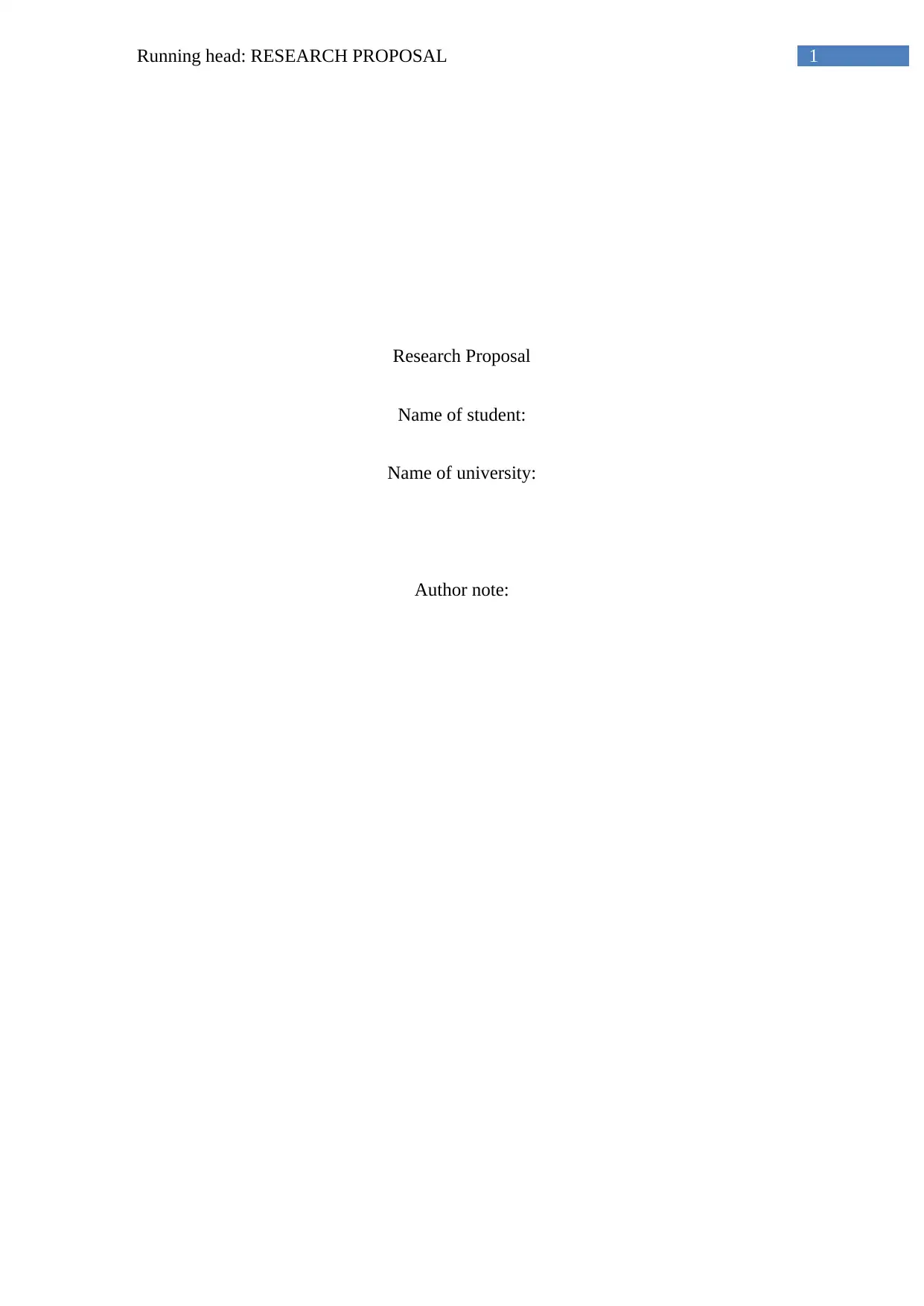
1Running head: RESEARCH PROPOSAL
Research Proposal
Name of student:
Name of university:
Author note:
Research Proposal
Name of student:
Name of university:
Author note:
Paraphrase This Document
Need a fresh take? Get an instant paraphrase of this document with our AI Paraphraser
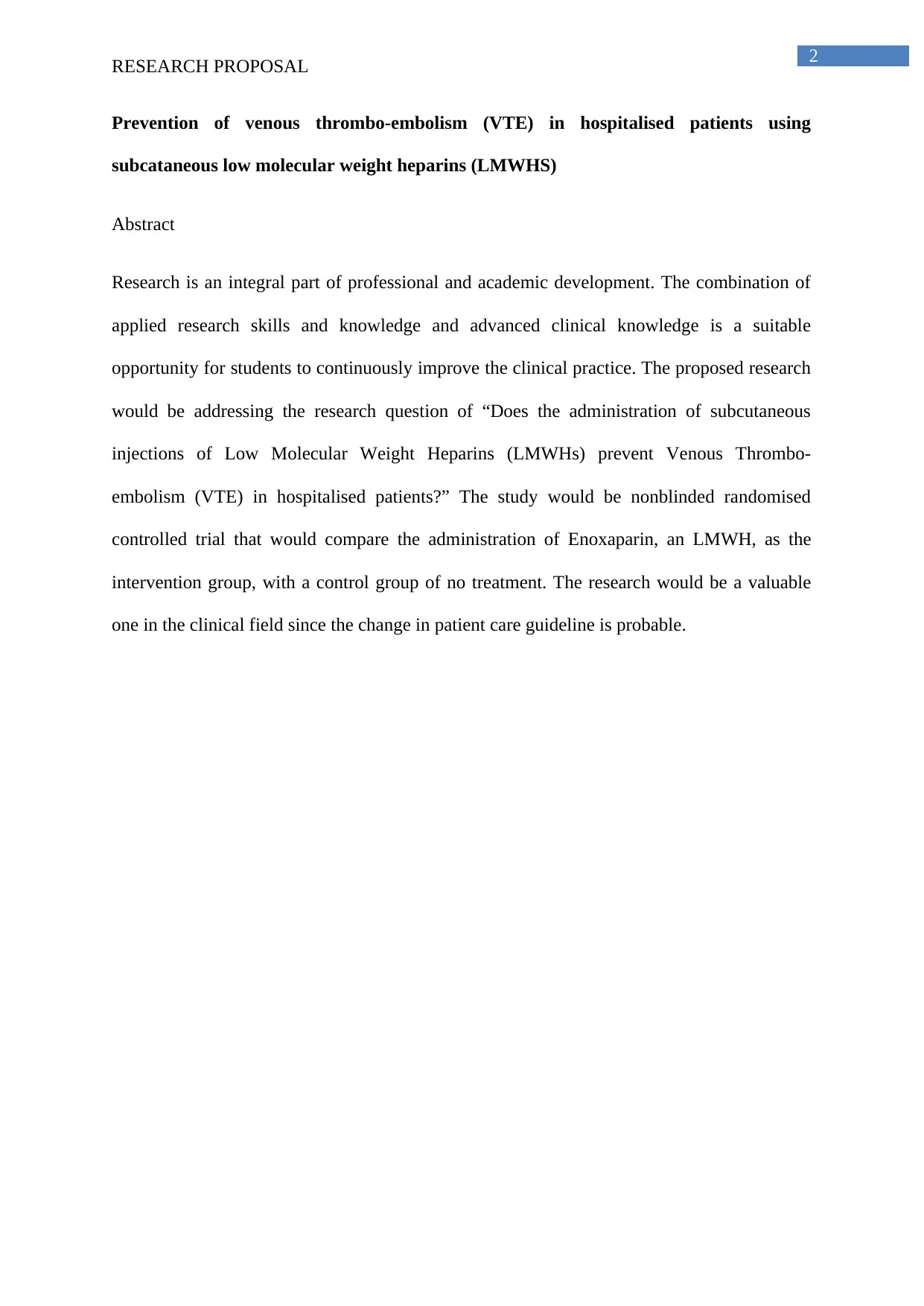
2
RESEARCH PROPOSAL
Prevention of venous thrombo-embolism (VTE) in hospitalised patients using
subcataneous low molecular weight heparins (LMWHS)
Abstract
Research is an integral part of professional and academic development. The combination of
applied research skills and knowledge and advanced clinical knowledge is a suitable
opportunity for students to continuously improve the clinical practice. The proposed research
would be addressing the research question of “Does the administration of subcutaneous
injections of Low Molecular Weight Heparins (LMWHs) prevent Venous Thrombo-
embolism (VTE) in hospitalised patients?” The study would be nonblinded randomised
controlled trial that would compare the administration of Enoxaparin, an LMWH, as the
intervention group, with a control group of no treatment. The research would be a valuable
one in the clinical field since the change in patient care guideline is probable.
RESEARCH PROPOSAL
Prevention of venous thrombo-embolism (VTE) in hospitalised patients using
subcataneous low molecular weight heparins (LMWHS)
Abstract
Research is an integral part of professional and academic development. The combination of
applied research skills and knowledge and advanced clinical knowledge is a suitable
opportunity for students to continuously improve the clinical practice. The proposed research
would be addressing the research question of “Does the administration of subcutaneous
injections of Low Molecular Weight Heparins (LMWHs) prevent Venous Thrombo-
embolism (VTE) in hospitalised patients?” The study would be nonblinded randomised
controlled trial that would compare the administration of Enoxaparin, an LMWH, as the
intervention group, with a control group of no treatment. The research would be a valuable
one in the clinical field since the change in patient care guideline is probable.
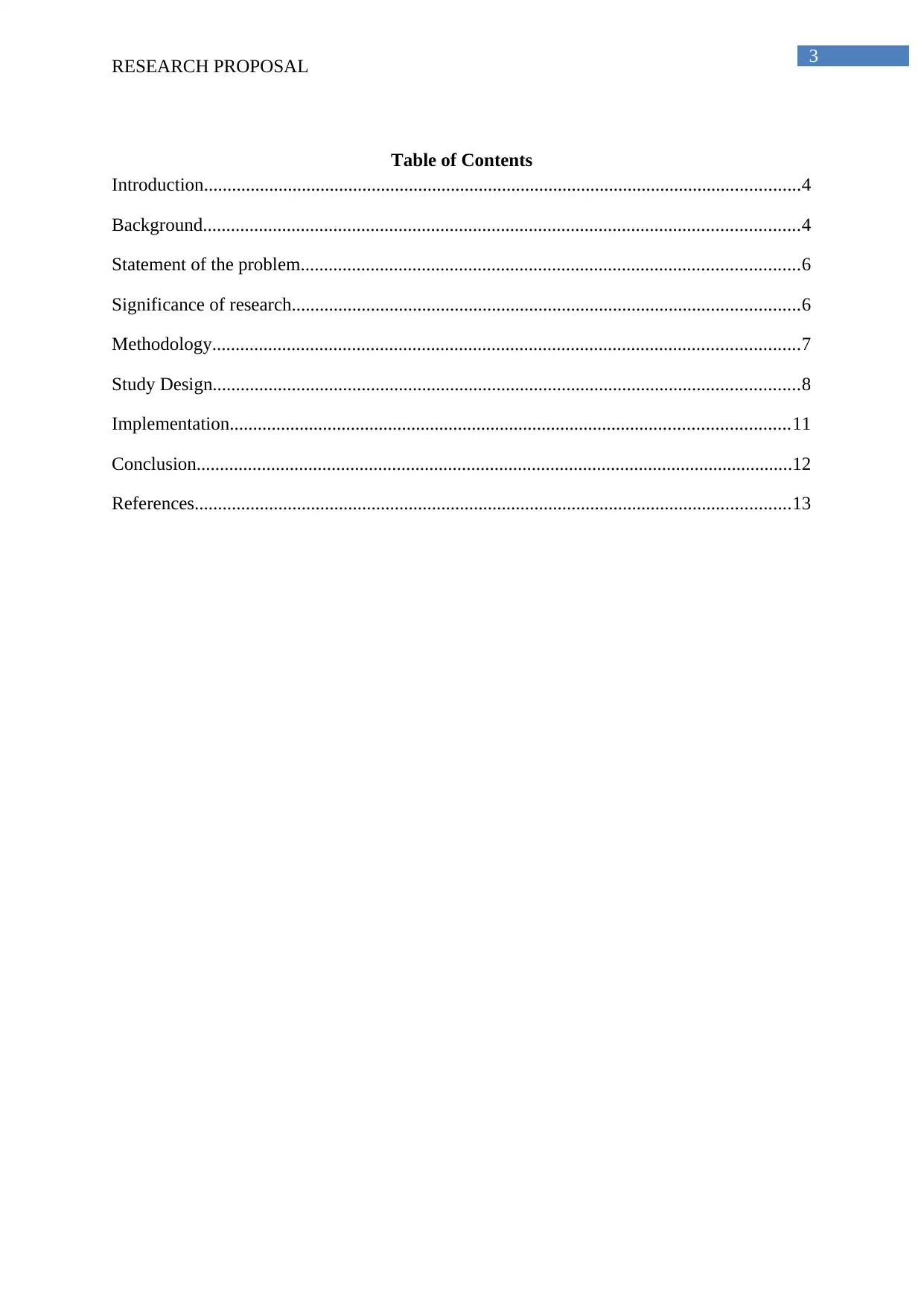
3
RESEARCH PROPOSAL
Table of Contents
Introduction................................................................................................................................4
Background................................................................................................................................4
Statement of the problem...........................................................................................................6
Significance of research.............................................................................................................6
Methodology..............................................................................................................................7
Study Design..............................................................................................................................8
Implementation........................................................................................................................11
Conclusion................................................................................................................................12
References................................................................................................................................13
RESEARCH PROPOSAL
Table of Contents
Introduction................................................................................................................................4
Background................................................................................................................................4
Statement of the problem...........................................................................................................6
Significance of research.............................................................................................................6
Methodology..............................................................................................................................7
Study Design..............................................................................................................................8
Implementation........................................................................................................................11
Conclusion................................................................................................................................12
References................................................................................................................................13
⊘ This is a preview!⊘
Do you want full access?
Subscribe today to unlock all pages.

Trusted by 1+ million students worldwide
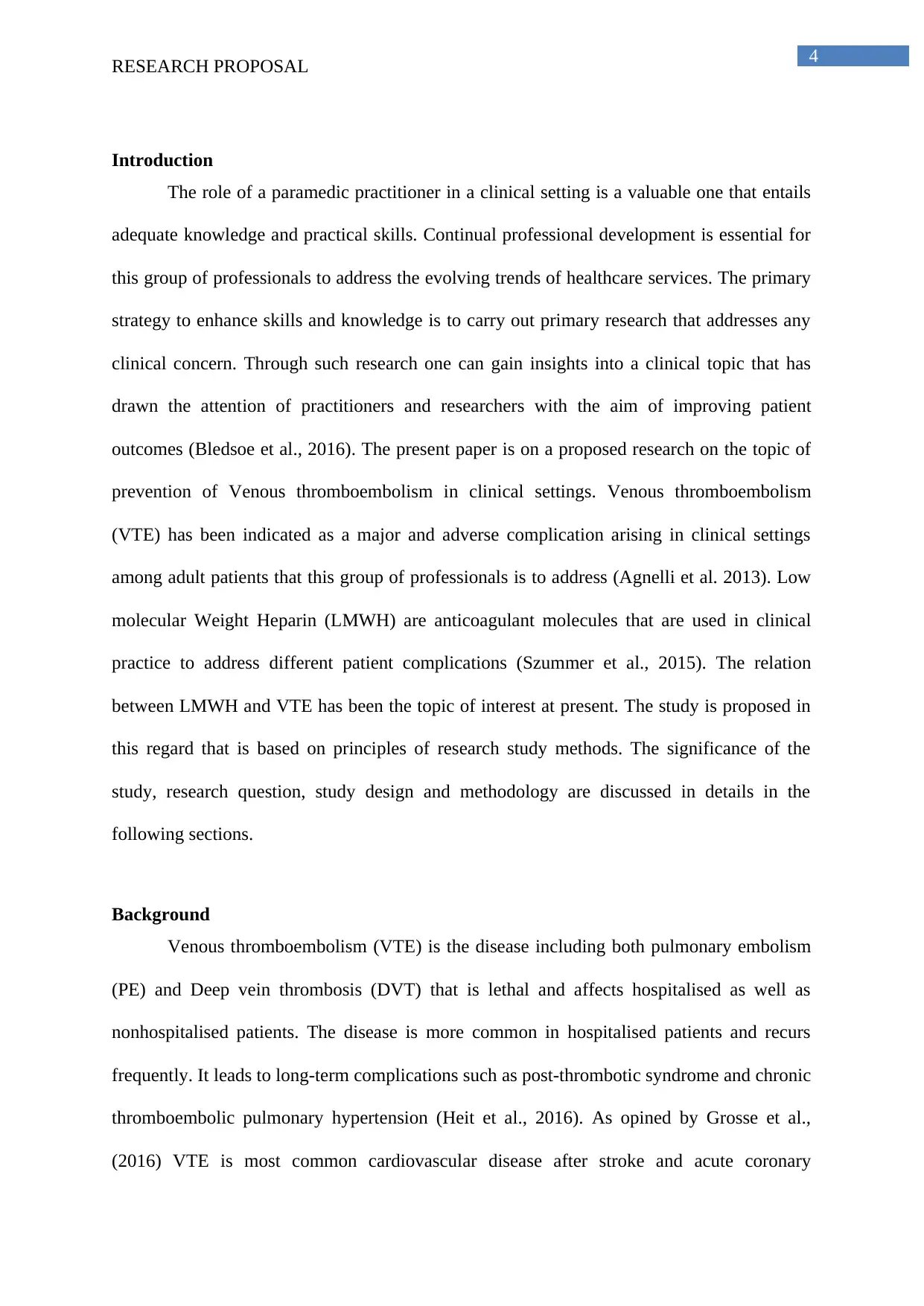
4
RESEARCH PROPOSAL
Introduction
The role of a paramedic practitioner in a clinical setting is a valuable one that entails
adequate knowledge and practical skills. Continual professional development is essential for
this group of professionals to address the evolving trends of healthcare services. The primary
strategy to enhance skills and knowledge is to carry out primary research that addresses any
clinical concern. Through such research one can gain insights into a clinical topic that has
drawn the attention of practitioners and researchers with the aim of improving patient
outcomes (Bledsoe et al., 2016). The present paper is on a proposed research on the topic of
prevention of Venous thromboembolism in clinical settings. Venous thromboembolism
(VTE) has been indicated as a major and adverse complication arising in clinical settings
among adult patients that this group of professionals is to address (Agnelli et al. 2013). Low
molecular Weight Heparin (LMWH) are anticoagulant molecules that are used in clinical
practice to address different patient complications (Szummer et al., 2015). The relation
between LMWH and VTE has been the topic of interest at present. The study is proposed in
this regard that is based on principles of research study methods. The significance of the
study, research question, study design and methodology are discussed in details in the
following sections.
Background
Venous thromboembolism (VTE) is the disease including both pulmonary embolism
(PE) and Deep vein thrombosis (DVT) that is lethal and affects hospitalised as well as
nonhospitalised patients. The disease is more common in hospitalised patients and recurs
frequently. It leads to long-term complications such as post-thrombotic syndrome and chronic
thromboembolic pulmonary hypertension (Heit et al., 2016). As opined by Grosse et al.,
(2016) VTE is most common cardiovascular disease after stroke and acute coronary
RESEARCH PROPOSAL
Introduction
The role of a paramedic practitioner in a clinical setting is a valuable one that entails
adequate knowledge and practical skills. Continual professional development is essential for
this group of professionals to address the evolving trends of healthcare services. The primary
strategy to enhance skills and knowledge is to carry out primary research that addresses any
clinical concern. Through such research one can gain insights into a clinical topic that has
drawn the attention of practitioners and researchers with the aim of improving patient
outcomes (Bledsoe et al., 2016). The present paper is on a proposed research on the topic of
prevention of Venous thromboembolism in clinical settings. Venous thromboembolism
(VTE) has been indicated as a major and adverse complication arising in clinical settings
among adult patients that this group of professionals is to address (Agnelli et al. 2013). Low
molecular Weight Heparin (LMWH) are anticoagulant molecules that are used in clinical
practice to address different patient complications (Szummer et al., 2015). The relation
between LMWH and VTE has been the topic of interest at present. The study is proposed in
this regard that is based on principles of research study methods. The significance of the
study, research question, study design and methodology are discussed in details in the
following sections.
Background
Venous thromboembolism (VTE) is the disease including both pulmonary embolism
(PE) and Deep vein thrombosis (DVT) that is lethal and affects hospitalised as well as
nonhospitalised patients. The disease is more common in hospitalised patients and recurs
frequently. It leads to long-term complications such as post-thrombotic syndrome and chronic
thromboembolic pulmonary hypertension (Heit et al., 2016). As opined by Grosse et al.,
(2016) VTE is most common cardiovascular disease after stroke and acute coronary
Paraphrase This Document
Need a fresh take? Get an instant paraphrase of this document with our AI Paraphraser
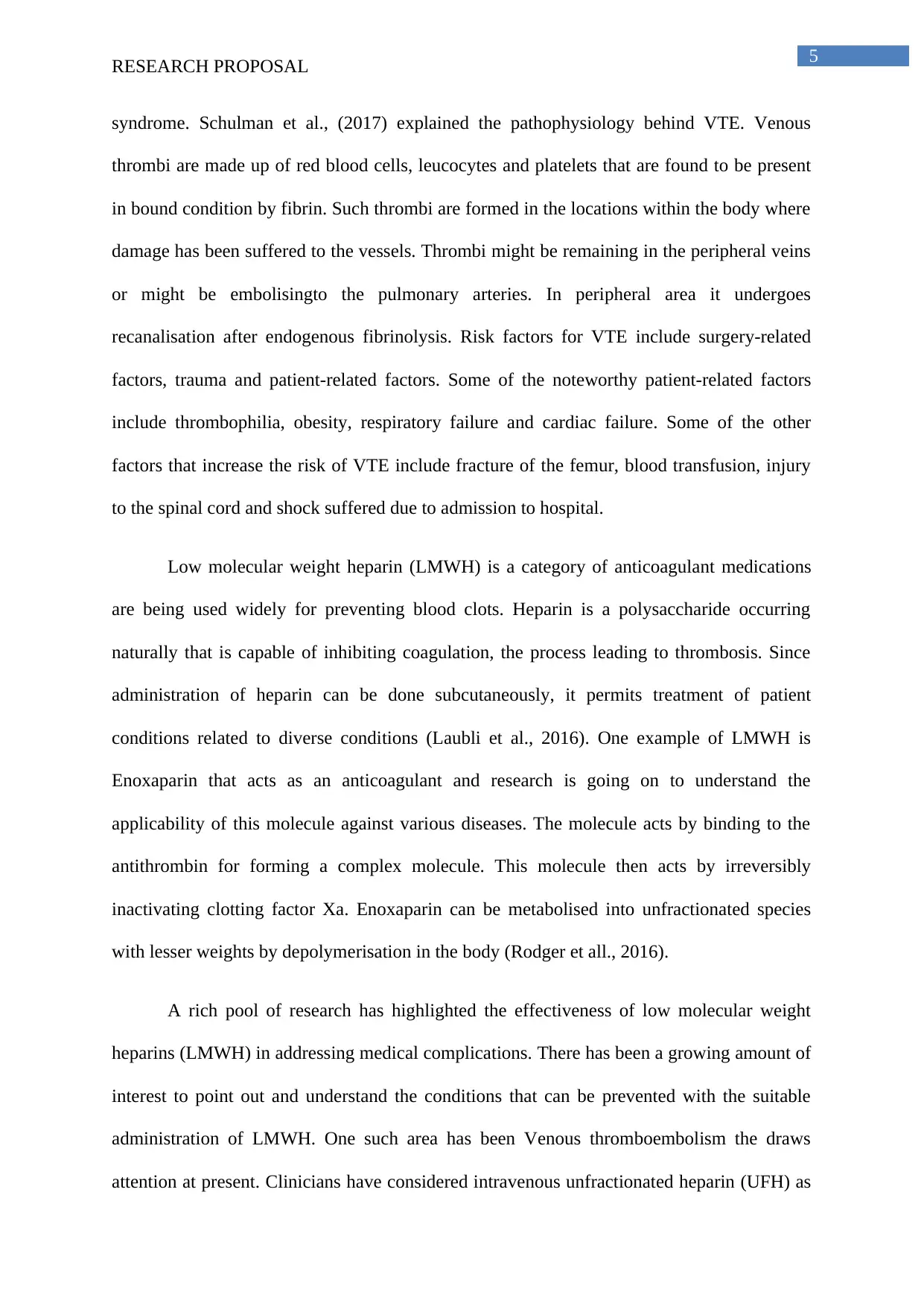
5
RESEARCH PROPOSAL
syndrome. Schulman et al., (2017) explained the pathophysiology behind VTE. Venous
thrombi are made up of red blood cells, leucocytes and platelets that are found to be present
in bound condition by fibrin. Such thrombi are formed in the locations within the body where
damage has been suffered to the vessels. Thrombi might be remaining in the peripheral veins
or might be embolisingto the pulmonary arteries. In peripheral area it undergoes
recanalisation after endogenous fibrinolysis. Risk factors for VTE include surgery-related
factors, trauma and patient-related factors. Some of the noteworthy patient-related factors
include thrombophilia, obesity, respiratory failure and cardiac failure. Some of the other
factors that increase the risk of VTE include fracture of the femur, blood transfusion, injury
to the spinal cord and shock suffered due to admission to hospital.
Low molecular weight heparin (LMWH) is a category of anticoagulant medications
are being used widely for preventing blood clots. Heparin is a polysaccharide occurring
naturally that is capable of inhibiting coagulation, the process leading to thrombosis. Since
administration of heparin can be done subcutaneously, it permits treatment of patient
conditions related to diverse conditions (Laubli et al., 2016). One example of LMWH is
Enoxaparin that acts as an anticoagulant and research is going on to understand the
applicability of this molecule against various diseases. The molecule acts by binding to the
antithrombin for forming a complex molecule. This molecule then acts by irreversibly
inactivating clotting factor Xa. Enoxaparin can be metabolised into unfractionated species
with lesser weights by depolymerisation in the body (Rodger et all., 2016).
A rich pool of research has highlighted the effectiveness of low molecular weight
heparins (LMWH) in addressing medical complications. There has been a growing amount of
interest to point out and understand the conditions that can be prevented with the suitable
administration of LMWH. One such area has been Venous thromboembolism the draws
attention at present. Clinicians have considered intravenous unfractionated heparin (UFH) as
RESEARCH PROPOSAL
syndrome. Schulman et al., (2017) explained the pathophysiology behind VTE. Venous
thrombi are made up of red blood cells, leucocytes and platelets that are found to be present
in bound condition by fibrin. Such thrombi are formed in the locations within the body where
damage has been suffered to the vessels. Thrombi might be remaining in the peripheral veins
or might be embolisingto the pulmonary arteries. In peripheral area it undergoes
recanalisation after endogenous fibrinolysis. Risk factors for VTE include surgery-related
factors, trauma and patient-related factors. Some of the noteworthy patient-related factors
include thrombophilia, obesity, respiratory failure and cardiac failure. Some of the other
factors that increase the risk of VTE include fracture of the femur, blood transfusion, injury
to the spinal cord and shock suffered due to admission to hospital.
Low molecular weight heparin (LMWH) is a category of anticoagulant medications
are being used widely for preventing blood clots. Heparin is a polysaccharide occurring
naturally that is capable of inhibiting coagulation, the process leading to thrombosis. Since
administration of heparin can be done subcutaneously, it permits treatment of patient
conditions related to diverse conditions (Laubli et al., 2016). One example of LMWH is
Enoxaparin that acts as an anticoagulant and research is going on to understand the
applicability of this molecule against various diseases. The molecule acts by binding to the
antithrombin for forming a complex molecule. This molecule then acts by irreversibly
inactivating clotting factor Xa. Enoxaparin can be metabolised into unfractionated species
with lesser weights by depolymerisation in the body (Rodger et all., 2016).
A rich pool of research has highlighted the effectiveness of low molecular weight
heparins (LMWH) in addressing medical complications. There has been a growing amount of
interest to point out and understand the conditions that can be prevented with the suitable
administration of LMWH. One such area has been Venous thromboembolism the draws
attention at present. Clinicians have considered intravenous unfractionated heparin (UFH) as
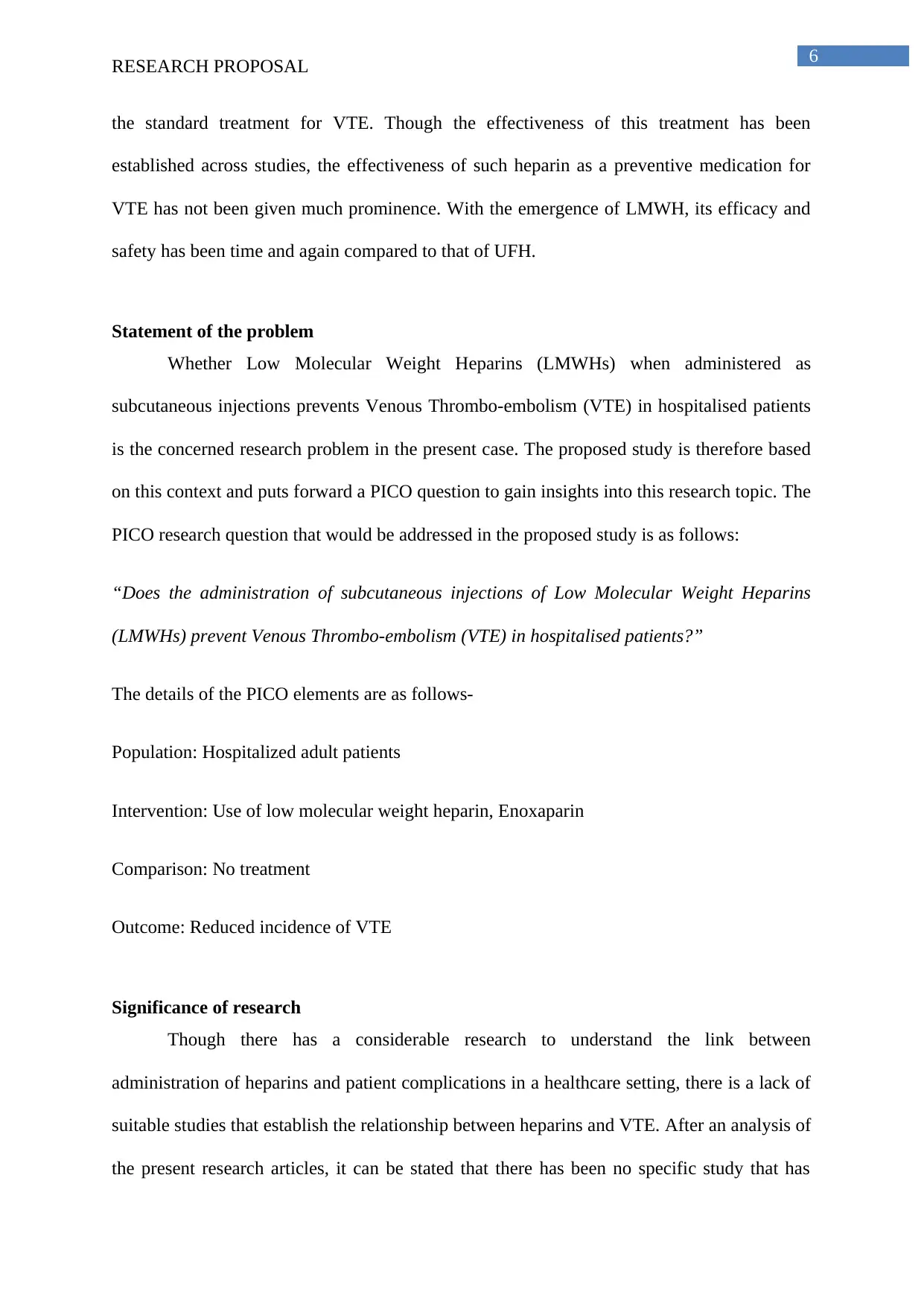
6
RESEARCH PROPOSAL
the standard treatment for VTE. Though the effectiveness of this treatment has been
established across studies, the effectiveness of such heparin as a preventive medication for
VTE has not been given much prominence. With the emergence of LMWH, its efficacy and
safety has been time and again compared to that of UFH.
Statement of the problem
Whether Low Molecular Weight Heparins (LMWHs) when administered as
subcutaneous injections prevents Venous Thrombo-embolism (VTE) in hospitalised patients
is the concerned research problem in the present case. The proposed study is therefore based
on this context and puts forward a PICO question to gain insights into this research topic. The
PICO research question that would be addressed in the proposed study is as follows:
“Does the administration of subcutaneous injections of Low Molecular Weight Heparins
(LMWHs) prevent Venous Thrombo-embolism (VTE) in hospitalised patients?”
The details of the PICO elements are as follows-
Population: Hospitalized adult patients
Intervention: Use of low molecular weight heparin, Enoxaparin
Comparison: No treatment
Outcome: Reduced incidence of VTE
Significance of research
Though there has a considerable research to understand the link between
administration of heparins and patient complications in a healthcare setting, there is a lack of
suitable studies that establish the relationship between heparins and VTE. After an analysis of
the present research articles, it can be stated that there has been no specific study that has
RESEARCH PROPOSAL
the standard treatment for VTE. Though the effectiveness of this treatment has been
established across studies, the effectiveness of such heparin as a preventive medication for
VTE has not been given much prominence. With the emergence of LMWH, its efficacy and
safety has been time and again compared to that of UFH.
Statement of the problem
Whether Low Molecular Weight Heparins (LMWHs) when administered as
subcutaneous injections prevents Venous Thrombo-embolism (VTE) in hospitalised patients
is the concerned research problem in the present case. The proposed study is therefore based
on this context and puts forward a PICO question to gain insights into this research topic. The
PICO research question that would be addressed in the proposed study is as follows:
“Does the administration of subcutaneous injections of Low Molecular Weight Heparins
(LMWHs) prevent Venous Thrombo-embolism (VTE) in hospitalised patients?”
The details of the PICO elements are as follows-
Population: Hospitalized adult patients
Intervention: Use of low molecular weight heparin, Enoxaparin
Comparison: No treatment
Outcome: Reduced incidence of VTE
Significance of research
Though there has a considerable research to understand the link between
administration of heparins and patient complications in a healthcare setting, there is a lack of
suitable studies that establish the relationship between heparins and VTE. After an analysis of
the present research articles, it can be stated that there has been no specific study that has
⊘ This is a preview!⊘
Do you want full access?
Subscribe today to unlock all pages.

Trusted by 1+ million students worldwide
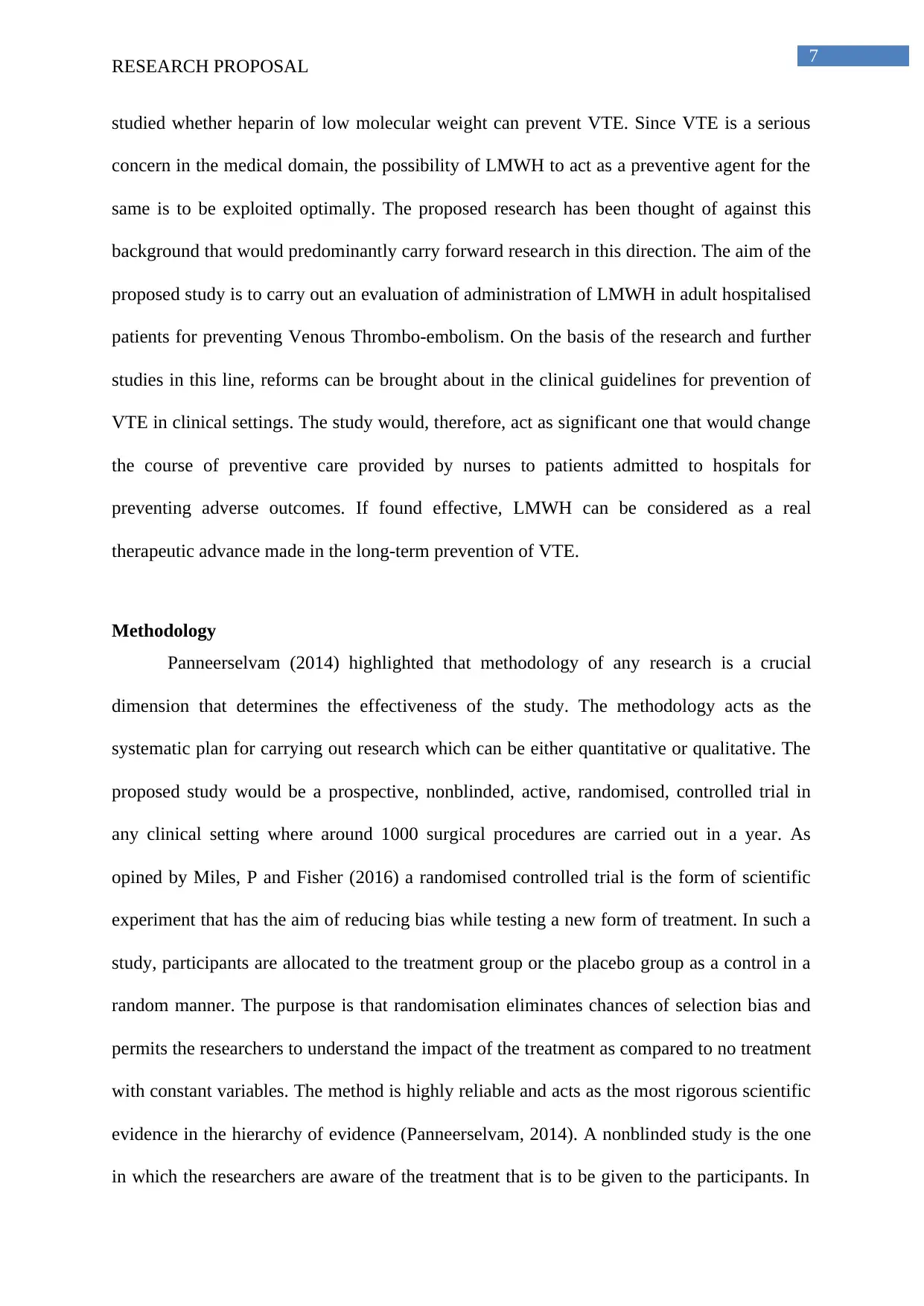
7
RESEARCH PROPOSAL
studied whether heparin of low molecular weight can prevent VTE. Since VTE is a serious
concern in the medical domain, the possibility of LMWH to act as a preventive agent for the
same is to be exploited optimally. The proposed research has been thought of against this
background that would predominantly carry forward research in this direction. The aim of the
proposed study is to carry out an evaluation of administration of LMWH in adult hospitalised
patients for preventing Venous Thrombo-embolism. On the basis of the research and further
studies in this line, reforms can be brought about in the clinical guidelines for prevention of
VTE in clinical settings. The study would, therefore, act as significant one that would change
the course of preventive care provided by nurses to patients admitted to hospitals for
preventing adverse outcomes. If found effective, LMWH can be considered as a real
therapeutic advance made in the long-term prevention of VTE.
Methodology
Panneerselvam (2014) highlighted that methodology of any research is a crucial
dimension that determines the effectiveness of the study. The methodology acts as the
systematic plan for carrying out research which can be either quantitative or qualitative. The
proposed study would be a prospective, nonblinded, active, randomised, controlled trial in
any clinical setting where around 1000 surgical procedures are carried out in a year. As
opined by Miles, P and Fisher (2016) a randomised controlled trial is the form of scientific
experiment that has the aim of reducing bias while testing a new form of treatment. In such a
study, participants are allocated to the treatment group or the placebo group as a control in a
random manner. The purpose is that randomisation eliminates chances of selection bias and
permits the researchers to understand the impact of the treatment as compared to no treatment
with constant variables. The method is highly reliable and acts as the most rigorous scientific
evidence in the hierarchy of evidence (Panneerselvam, 2014). A nonblinded study is the one
in which the researchers are aware of the treatment that is to be given to the participants. In
RESEARCH PROPOSAL
studied whether heparin of low molecular weight can prevent VTE. Since VTE is a serious
concern in the medical domain, the possibility of LMWH to act as a preventive agent for the
same is to be exploited optimally. The proposed research has been thought of against this
background that would predominantly carry forward research in this direction. The aim of the
proposed study is to carry out an evaluation of administration of LMWH in adult hospitalised
patients for preventing Venous Thrombo-embolism. On the basis of the research and further
studies in this line, reforms can be brought about in the clinical guidelines for prevention of
VTE in clinical settings. The study would, therefore, act as significant one that would change
the course of preventive care provided by nurses to patients admitted to hospitals for
preventing adverse outcomes. If found effective, LMWH can be considered as a real
therapeutic advance made in the long-term prevention of VTE.
Methodology
Panneerselvam (2014) highlighted that methodology of any research is a crucial
dimension that determines the effectiveness of the study. The methodology acts as the
systematic plan for carrying out research which can be either quantitative or qualitative. The
proposed study would be a prospective, nonblinded, active, randomised, controlled trial in
any clinical setting where around 1000 surgical procedures are carried out in a year. As
opined by Miles, P and Fisher (2016) a randomised controlled trial is the form of scientific
experiment that has the aim of reducing bias while testing a new form of treatment. In such a
study, participants are allocated to the treatment group or the placebo group as a control in a
random manner. The purpose is that randomisation eliminates chances of selection bias and
permits the researchers to understand the impact of the treatment as compared to no treatment
with constant variables. The method is highly reliable and acts as the most rigorous scientific
evidence in the hierarchy of evidence (Panneerselvam, 2014). A nonblinded study is the one
in which the researchers are aware of the treatment that is to be given to the participants. In
Paraphrase This Document
Need a fresh take? Get an instant paraphrase of this document with our AI Paraphraser
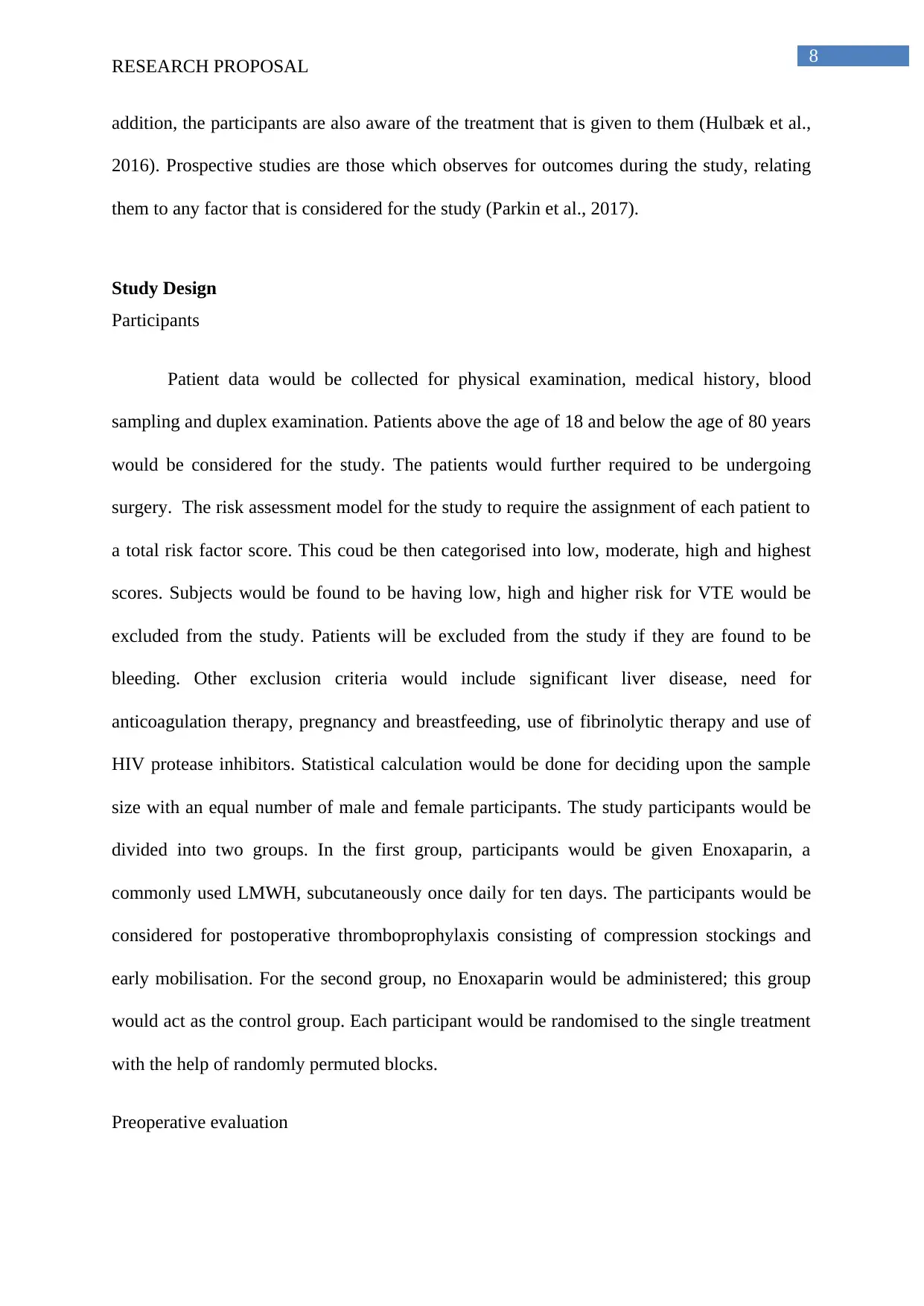
8
RESEARCH PROPOSAL
addition, the participants are also aware of the treatment that is given to them (Hulbæk et al.,
2016). Prospective studies are those which observes for outcomes during the study, relating
them to any factor that is considered for the study (Parkin et al., 2017).
Study Design
Participants
Patient data would be collected for physical examination, medical history, blood
sampling and duplex examination. Patients above the age of 18 and below the age of 80 years
would be considered for the study. The patients would further required to be undergoing
surgery. The risk assessment model for the study to require the assignment of each patient to
a total risk factor score. This coud be then categorised into low, moderate, high and highest
scores. Subjects would be found to be having low, high and higher risk for VTE would be
excluded from the study. Patients will be excluded from the study if they are found to be
bleeding. Other exclusion criteria would include significant liver disease, need for
anticoagulation therapy, pregnancy and breastfeeding, use of fibrinolytic therapy and use of
HIV protease inhibitors. Statistical calculation would be done for deciding upon the sample
size with an equal number of male and female participants. The study participants would be
divided into two groups. In the first group, participants would be given Enoxaparin, a
commonly used LMWH, subcutaneously once daily for ten days. The participants would be
considered for postoperative thromboprophylaxis consisting of compression stockings and
early mobilisation. For the second group, no Enoxaparin would be administered; this group
would act as the control group. Each participant would be randomised to the single treatment
with the help of randomly permuted blocks.
Preoperative evaluation
RESEARCH PROPOSAL
addition, the participants are also aware of the treatment that is given to them (Hulbæk et al.,
2016). Prospective studies are those which observes for outcomes during the study, relating
them to any factor that is considered for the study (Parkin et al., 2017).
Study Design
Participants
Patient data would be collected for physical examination, medical history, blood
sampling and duplex examination. Patients above the age of 18 and below the age of 80 years
would be considered for the study. The patients would further required to be undergoing
surgery. The risk assessment model for the study to require the assignment of each patient to
a total risk factor score. This coud be then categorised into low, moderate, high and highest
scores. Subjects would be found to be having low, high and higher risk for VTE would be
excluded from the study. Patients will be excluded from the study if they are found to be
bleeding. Other exclusion criteria would include significant liver disease, need for
anticoagulation therapy, pregnancy and breastfeeding, use of fibrinolytic therapy and use of
HIV protease inhibitors. Statistical calculation would be done for deciding upon the sample
size with an equal number of male and female participants. The study participants would be
divided into two groups. In the first group, participants would be given Enoxaparin, a
commonly used LMWH, subcutaneously once daily for ten days. The participants would be
considered for postoperative thromboprophylaxis consisting of compression stockings and
early mobilisation. For the second group, no Enoxaparin would be administered; this group
would act as the control group. Each participant would be randomised to the single treatment
with the help of randomly permuted blocks.
Preoperative evaluation
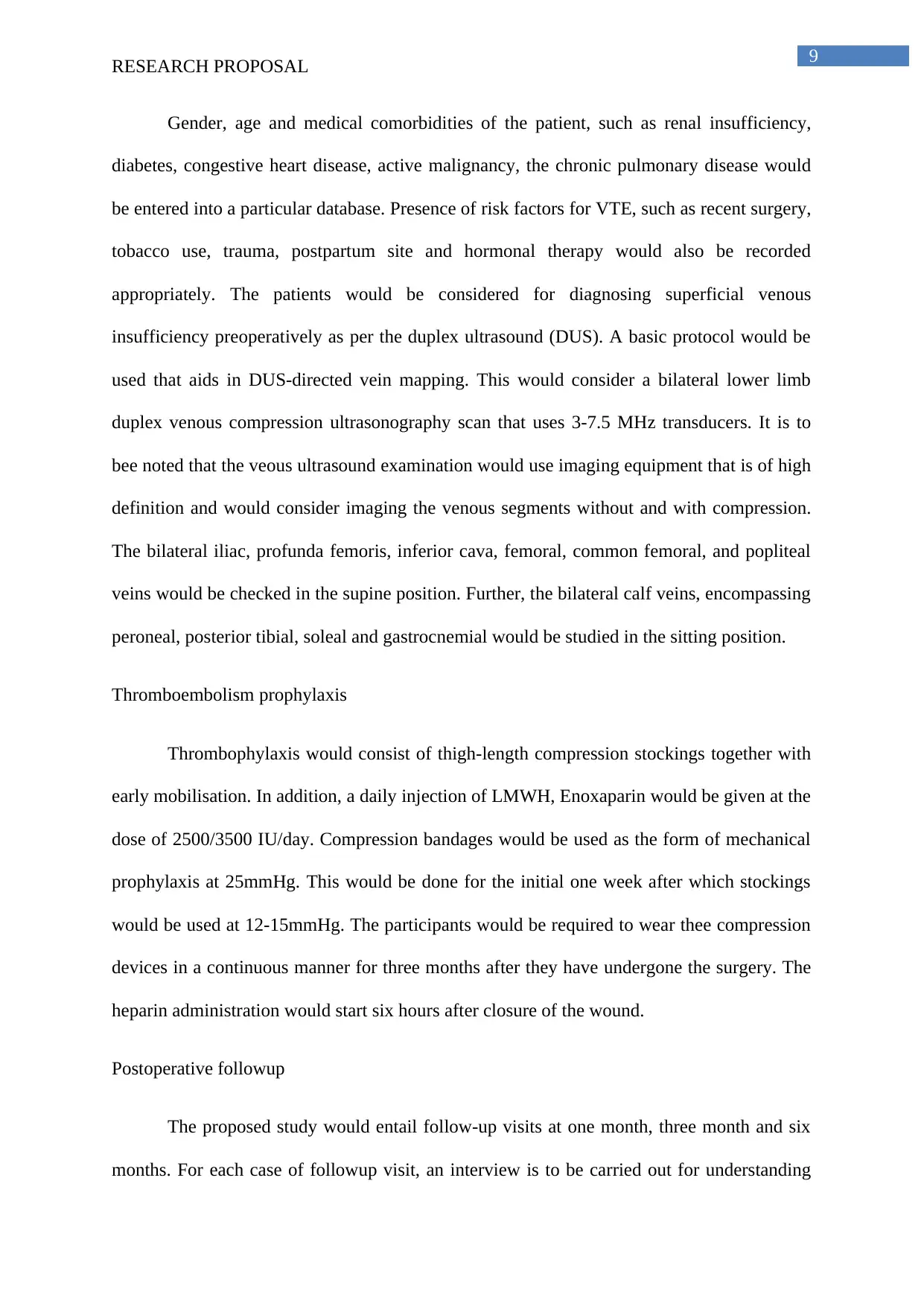
9
RESEARCH PROPOSAL
Gender, age and medical comorbidities of the patient, such as renal insufficiency,
diabetes, congestive heart disease, active malignancy, the chronic pulmonary disease would
be entered into a particular database. Presence of risk factors for VTE, such as recent surgery,
tobacco use, trauma, postpartum site and hormonal therapy would also be recorded
appropriately. The patients would be considered for diagnosing superficial venous
insufficiency preoperatively as per the duplex ultrasound (DUS). A basic protocol would be
used that aids in DUS-directed vein mapping. This would consider a bilateral lower limb
duplex venous compression ultrasonography scan that uses 3-7.5 MHz transducers. It is to
bee noted that the veous ultrasound examination would use imaging equipment that is of high
definition and would consider imaging the venous segments without and with compression.
The bilateral iliac, profunda femoris, inferior cava, femoral, common femoral, and popliteal
veins would be checked in the supine position. Further, the bilateral calf veins, encompassing
peroneal, posterior tibial, soleal and gastrocnemial would be studied in the sitting position.
Thromboembolism prophylaxis
Thrombophylaxis would consist of thigh-length compression stockings together with
early mobilisation. In addition, a daily injection of LMWH, Enoxaparin would be given at the
dose of 2500/3500 IU/day. Compression bandages would be used as the form of mechanical
prophylaxis at 25mmHg. This would be done for the initial one week after which stockings
would be used at 12-15mmHg. The participants would be required to wear thee compression
devices in a continuous manner for three months after they have undergone the surgery. The
heparin administration would start six hours after closure of the wound.
Postoperative followup
The proposed study would entail follow-up visits at one month, three month and six
months. For each case of followup visit, an interview is to be carried out for understanding
RESEARCH PROPOSAL
Gender, age and medical comorbidities of the patient, such as renal insufficiency,
diabetes, congestive heart disease, active malignancy, the chronic pulmonary disease would
be entered into a particular database. Presence of risk factors for VTE, such as recent surgery,
tobacco use, trauma, postpartum site and hormonal therapy would also be recorded
appropriately. The patients would be considered for diagnosing superficial venous
insufficiency preoperatively as per the duplex ultrasound (DUS). A basic protocol would be
used that aids in DUS-directed vein mapping. This would consider a bilateral lower limb
duplex venous compression ultrasonography scan that uses 3-7.5 MHz transducers. It is to
bee noted that the veous ultrasound examination would use imaging equipment that is of high
definition and would consider imaging the venous segments without and with compression.
The bilateral iliac, profunda femoris, inferior cava, femoral, common femoral, and popliteal
veins would be checked in the supine position. Further, the bilateral calf veins, encompassing
peroneal, posterior tibial, soleal and gastrocnemial would be studied in the sitting position.
Thromboembolism prophylaxis
Thrombophylaxis would consist of thigh-length compression stockings together with
early mobilisation. In addition, a daily injection of LMWH, Enoxaparin would be given at the
dose of 2500/3500 IU/day. Compression bandages would be used as the form of mechanical
prophylaxis at 25mmHg. This would be done for the initial one week after which stockings
would be used at 12-15mmHg. The participants would be required to wear thee compression
devices in a continuous manner for three months after they have undergone the surgery. The
heparin administration would start six hours after closure of the wound.
Postoperative followup
The proposed study would entail follow-up visits at one month, three month and six
months. For each case of followup visit, an interview is to be carried out for understanding
⊘ This is a preview!⊘
Do you want full access?
Subscribe today to unlock all pages.

Trusted by 1+ million students worldwide
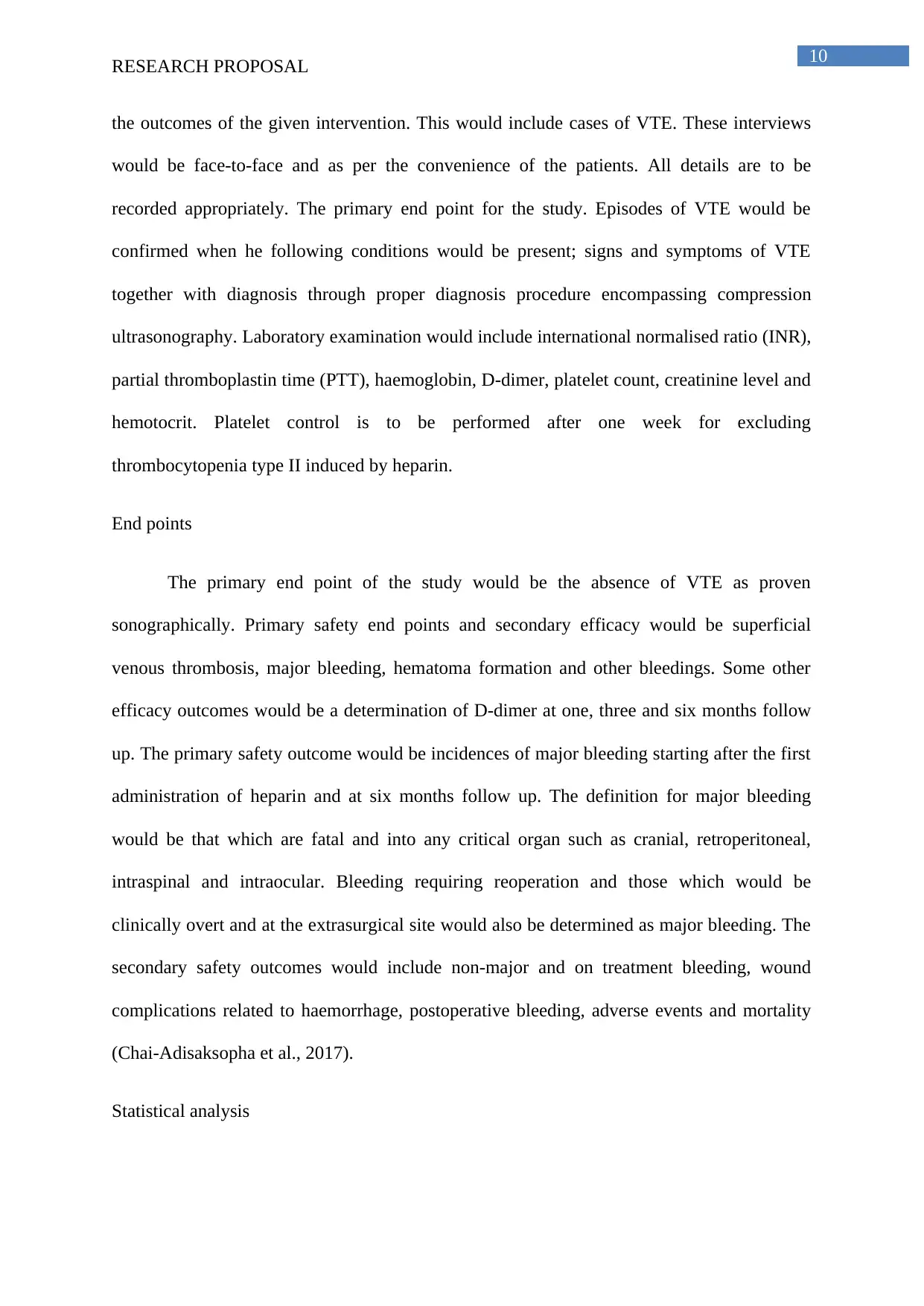
10
RESEARCH PROPOSAL
the outcomes of the given intervention. This would include cases of VTE. These interviews
would be face-to-face and as per the convenience of the patients. All details are to be
recorded appropriately. The primary end point for the study. Episodes of VTE would be
confirmed when he following conditions would be present; signs and symptoms of VTE
together with diagnosis through proper diagnosis procedure encompassing compression
ultrasonography. Laboratory examination would include international normalised ratio (INR),
partial thromboplastin time (PTT), haemoglobin, D-dimer, platelet count, creatinine level and
hemotocrit. Platelet control is to be performed after one week for excluding
thrombocytopenia type II induced by heparin.
End points
The primary end point of the study would be the absence of VTE as proven
sonographically. Primary safety end points and secondary efficacy would be superficial
venous thrombosis, major bleeding, hematoma formation and other bleedings. Some other
efficacy outcomes would be a determination of D-dimer at one, three and six months follow
up. The primary safety outcome would be incidences of major bleeding starting after the first
administration of heparin and at six months follow up. The definition for major bleeding
would be that which are fatal and into any critical organ such as cranial, retroperitoneal,
intraspinal and intraocular. Bleeding requiring reoperation and those which would be
clinically overt and at the extrasurgical site would also be determined as major bleeding. The
secondary safety outcomes would include non-major and on treatment bleeding, wound
complications related to haemorrhage, postoperative bleeding, adverse events and mortality
(Chai-Adisaksopha et al., 2017).
Statistical analysis
RESEARCH PROPOSAL
the outcomes of the given intervention. This would include cases of VTE. These interviews
would be face-to-face and as per the convenience of the patients. All details are to be
recorded appropriately. The primary end point for the study. Episodes of VTE would be
confirmed when he following conditions would be present; signs and symptoms of VTE
together with diagnosis through proper diagnosis procedure encompassing compression
ultrasonography. Laboratory examination would include international normalised ratio (INR),
partial thromboplastin time (PTT), haemoglobin, D-dimer, platelet count, creatinine level and
hemotocrit. Platelet control is to be performed after one week for excluding
thrombocytopenia type II induced by heparin.
End points
The primary end point of the study would be the absence of VTE as proven
sonographically. Primary safety end points and secondary efficacy would be superficial
venous thrombosis, major bleeding, hematoma formation and other bleedings. Some other
efficacy outcomes would be a determination of D-dimer at one, three and six months follow
up. The primary safety outcome would be incidences of major bleeding starting after the first
administration of heparin and at six months follow up. The definition for major bleeding
would be that which are fatal and into any critical organ such as cranial, retroperitoneal,
intraspinal and intraocular. Bleeding requiring reoperation and those which would be
clinically overt and at the extrasurgical site would also be determined as major bleeding. The
secondary safety outcomes would include non-major and on treatment bleeding, wound
complications related to haemorrhage, postoperative bleeding, adverse events and mortality
(Chai-Adisaksopha et al., 2017).
Statistical analysis
Paraphrase This Document
Need a fresh take? Get an instant paraphrase of this document with our AI Paraphraser

11
RESEARCH PROPOSAL
The basis for the calculation of sample size would be assumed event rate of 15% in
the moderate risk group and a risk reduction of 10% with LMWH. Differences between
research outcomes and patient characteristics would be calculated with the help of the Mann-
Whitney U-test. In addition, two-sided Fisher’s exact test would be done. A value of P< 0.05
would be statistically significant. An interim analysis would be done at three months. The
Mann-Whitney U test is a commonly used nonparametric test that determines whether a
randomly selected value from one sample would be lesser than or greater than a randomly
selected value from another sample. It does not need the basic assumptions of normal
distributions though the efficiency is as that of the t-test. The utility of the test lies when two
samples that are independent from each other are to be selected from a population with same
distribution (Beins & McCarthy, 2017). Two sided Fisher’s exact test is a test of statistical
significance that is used in case of categorical data (Connelly, 2016).
Implementation
The protocol for the study is to be approved by the institutional review board at the
hospital and in accordance with the local regulations. Ethical considerations remain when
human participants are considered for a study. In this view it would be necessary to obtain
informed consent from patients who would take part in the study. Informed consent refers to
the process of agreeing to take part in any research procedure after understanding the benefits
and risks of the such participation. The process entails explaining the participants the purpose
and objective of the research and outlining the potential risks and complications. Informed
consent is primitive on the basis of legal and moral premises of the patient’s autonomy. The
patients would not be influenced in any manner to take part in the study (Panneerselvam,
2014). The primary outcome measure of the trial would be postoperative VTE over a
followup period of six months. The secondary outcome measure would include superficial
venous thrombosis, postoperative bleeding complications.
RESEARCH PROPOSAL
The basis for the calculation of sample size would be assumed event rate of 15% in
the moderate risk group and a risk reduction of 10% with LMWH. Differences between
research outcomes and patient characteristics would be calculated with the help of the Mann-
Whitney U-test. In addition, two-sided Fisher’s exact test would be done. A value of P< 0.05
would be statistically significant. An interim analysis would be done at three months. The
Mann-Whitney U test is a commonly used nonparametric test that determines whether a
randomly selected value from one sample would be lesser than or greater than a randomly
selected value from another sample. It does not need the basic assumptions of normal
distributions though the efficiency is as that of the t-test. The utility of the test lies when two
samples that are independent from each other are to be selected from a population with same
distribution (Beins & McCarthy, 2017). Two sided Fisher’s exact test is a test of statistical
significance that is used in case of categorical data (Connelly, 2016).
Implementation
The protocol for the study is to be approved by the institutional review board at the
hospital and in accordance with the local regulations. Ethical considerations remain when
human participants are considered for a study. In this view it would be necessary to obtain
informed consent from patients who would take part in the study. Informed consent refers to
the process of agreeing to take part in any research procedure after understanding the benefits
and risks of the such participation. The process entails explaining the participants the purpose
and objective of the research and outlining the potential risks and complications. Informed
consent is primitive on the basis of legal and moral premises of the patient’s autonomy. The
patients would not be influenced in any manner to take part in the study (Panneerselvam,
2014). The primary outcome measure of the trial would be postoperative VTE over a
followup period of six months. The secondary outcome measure would include superficial
venous thrombosis, postoperative bleeding complications.
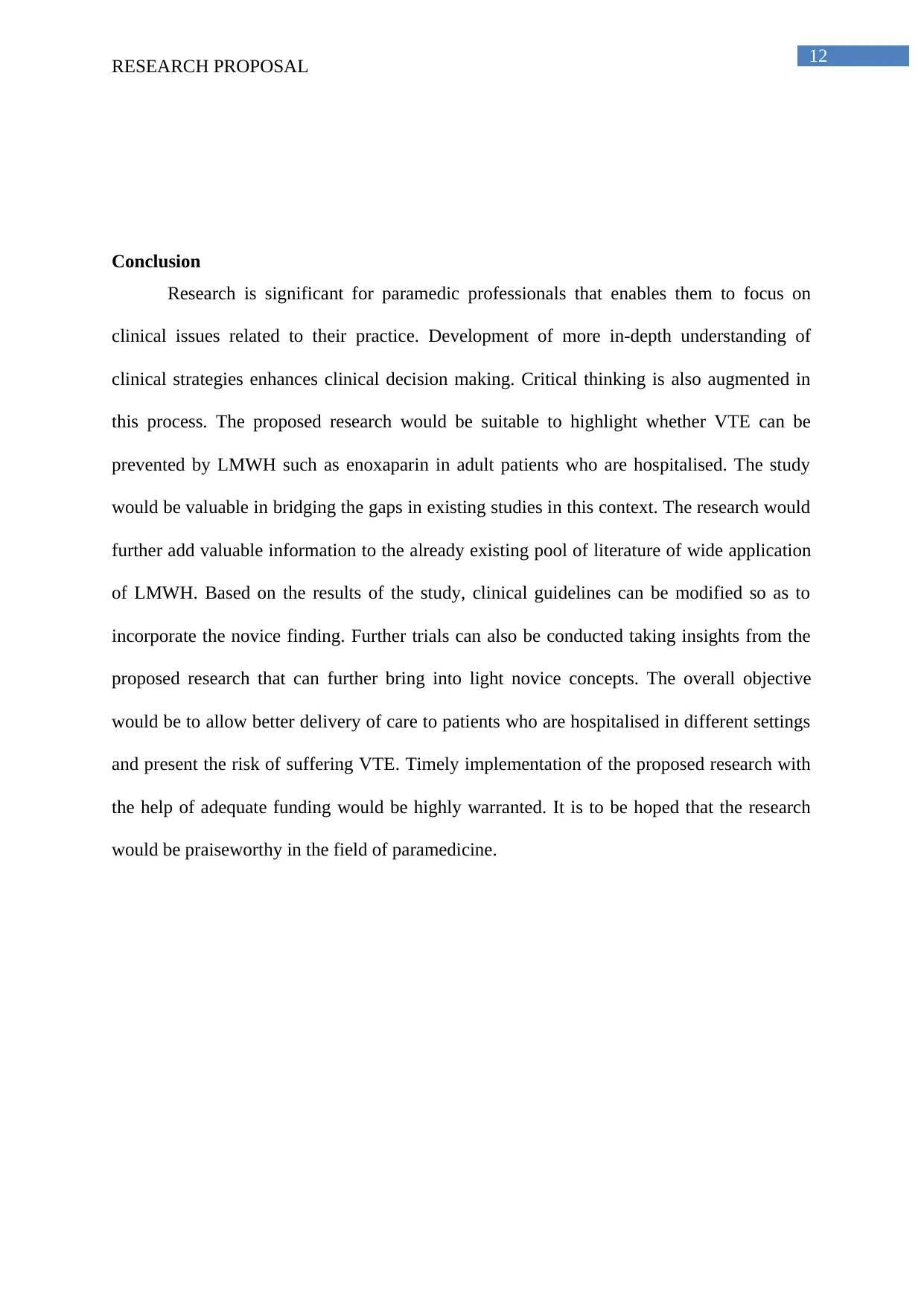
12
RESEARCH PROPOSAL
Conclusion
Research is significant for paramedic professionals that enables them to focus on
clinical issues related to their practice. Development of more in-depth understanding of
clinical strategies enhances clinical decision making. Critical thinking is also augmented in
this process. The proposed research would be suitable to highlight whether VTE can be
prevented by LMWH such as enoxaparin in adult patients who are hospitalised. The study
would be valuable in bridging the gaps in existing studies in this context. The research would
further add valuable information to the already existing pool of literature of wide application
of LMWH. Based on the results of the study, clinical guidelines can be modified so as to
incorporate the novice finding. Further trials can also be conducted taking insights from the
proposed research that can further bring into light novice concepts. The overall objective
would be to allow better delivery of care to patients who are hospitalised in different settings
and present the risk of suffering VTE. Timely implementation of the proposed research with
the help of adequate funding would be highly warranted. It is to be hoped that the research
would be praiseworthy in the field of paramedicine.
RESEARCH PROPOSAL
Conclusion
Research is significant for paramedic professionals that enables them to focus on
clinical issues related to their practice. Development of more in-depth understanding of
clinical strategies enhances clinical decision making. Critical thinking is also augmented in
this process. The proposed research would be suitable to highlight whether VTE can be
prevented by LMWH such as enoxaparin in adult patients who are hospitalised. The study
would be valuable in bridging the gaps in existing studies in this context. The research would
further add valuable information to the already existing pool of literature of wide application
of LMWH. Based on the results of the study, clinical guidelines can be modified so as to
incorporate the novice finding. Further trials can also be conducted taking insights from the
proposed research that can further bring into light novice concepts. The overall objective
would be to allow better delivery of care to patients who are hospitalised in different settings
and present the risk of suffering VTE. Timely implementation of the proposed research with
the help of adequate funding would be highly warranted. It is to be hoped that the research
would be praiseworthy in the field of paramedicine.
⊘ This is a preview!⊘
Do you want full access?
Subscribe today to unlock all pages.

Trusted by 1+ million students worldwide
1 out of 14
Related Documents
Your All-in-One AI-Powered Toolkit for Academic Success.
+13062052269
info@desklib.com
Available 24*7 on WhatsApp / Email
![[object Object]](/_next/static/media/star-bottom.7253800d.svg)
Unlock your academic potential
Copyright © 2020–2025 A2Z Services. All Rights Reserved. Developed and managed by ZUCOL.





